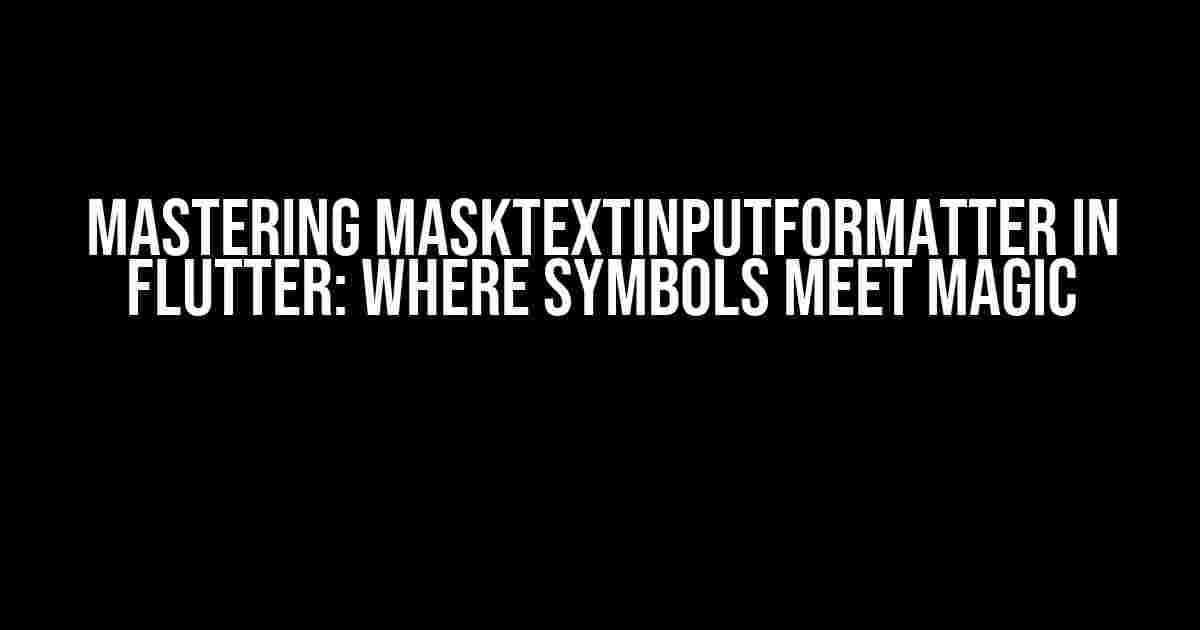Hey there, Flutter enthusiasts! Are you tired of dealing with pesky user input errors? Do you want to elevate your app’s user experience by allowing users to enter specific formats of data, like credit card numbers or dates? Look no further! In this comprehensive guide, we’ll delve into the wonderful world of MaskTextInputFormatter in Flutter, where symbols meet magic.
What is MaskTextInputFormatter?
MaskTextInputFormatter is a powerful tool in Flutter that enables you to format user input in real-time, ensuring that users enter data in a specific format. This formatter uses a set of rules, defined by a mask, to transform user input into a predetermined format. Think of it as a superhero cape that saves the day by preventing errors and making data entry a breeze!
Why Do I Need MaskTextInputFormatter?
Imagine you’re building a banking app that requires users to enter their credit card numbers. Without MaskTextInputFormatter, users might enter their card numbers in various formats, leading to errors and frustration. By using this formatter, you can ensure that users enter their card numbers in a standardized format, like ####-####-####-####, making it easier for them and your app to process the data.
Basic Usage of MaskTextInputFormatter
To get started with MaskTextInputFormatter, you’ll need to import the flutter_masked_text package in your Flutter project. Add the following line to your pubspec.yaml file:
dependencies: flutter_masked_text: ^0.8.0
Next, create a TextField or TextFormField widget and pass an instance of MaskTextInputFormatter to its inputFormatters property:
import 'package:flutter/material.dart';
import 'package:flutter_masked_text/flutter_masked_text.dart';
class CreditCardInput extends StatefulWidget {
@override
_CreditCardInputState createState() => _CreditCardInputState();
}
class _CreditCardInputState extends State<CreditCardInput> {
final _creditCardController = MaskTextInputFormatter(
mask: '####-####-####-####', // define the mask
filter: {
'#': RegExp(r'[0-9]'), // allow only digits
},
);
@override
Widget build(BuildContext context) {
return TextFormField(
decoration: InputDecoration(
labelText: 'Credit Card Number',
),
controller: _creditCardController,
inputFormatters: [_creditCardController], // pass the formatter
);
}
}
Advanced MaskTextInputFormatter Techniques
Now that you’ve mastered the basics, let’s explore some advanced techniques to take your formatting skills to the next level!
Using Multiple Masks
Sometimes, you might need to apply different masks to a single input field. For example, you want to format a phone number as (###) ###-####, but also allow users to enter an extension in the format ####x####. You can achieve this by using multiple masks:
final _phoneController = MaskTextInputFormatter(
mask: ['(###) ###-####', '####x####'],
filter: {
'#': RegExp(r'[0-9]'),
},
);
Customizing the Mask
You can customize the mask by using pattern characters, such as:
#: Digit (0-9)*: Alphanumeric (A-Za-z0-9)A: Uppercase letter (A-Z)a: Lowercase letter (a-z)_: Underscore
For example, to format a social security number as ###-##-####, you can use the following mask:
final _ssnController = MaskTextInputFormatter(
mask: '###-##-####',
filter: {
'#': RegExp(r'[0-9]'),
},
);
Handling Mask Changes
What if you need to change the mask dynamically based on user input? You can achieve this by creating a function that updates the mask and then calls setState to rebuild the widget:
void _updateMask() {
if (_creditCardController.text.length > 16) {
_creditCardController.mask = '####-####-####-####-####'; // new mask
} else {
_creditCardController.mask = '####-####-####-####'; // original mask
}
setState(() {});
}
Troubleshooting Common Issues
Don’t worry, we’ve all been there! Here are some common issues you might encounter when using MaskTextInputFormatter, along with their solutions:
Issue: The mask is not applied
Solution: Make sure to pass the MaskTextInputFormatter instance to the inputFormatters property of the TextField or TextFormField widget.
Issue: The mask is not updated dynamically
Solution: Call setState after updating the mask to trigger a rebuild of the widget.
Issue: The user can still enter invalid characters
Solution: Ensure that you’ve defined a filter for the mask using the filter property, as shown in the examples above.
Conclusion
And there you have it, folks! With MaskTextInputFormatter, you can create a seamless and error-free user experience for your Flutter app. By mastering this powerful tool, you’ll be able to format user input in real-time, making it easier for users to enter data accurately and efficiently.
Remember, practice makes perfect, so go ahead and experiment with different masks and techniques to take your app to the next level!
| Symbol | Description |
|---|---|
# |
Digit (0-9) |
* |
Alphanumeric (A-Za-z0-9) |
A |
Uppercase letter (A-Z) |
a |
Lowercase letter (a-z) |
_ |
Underscore |
Happy coding, and don’t forget to format your way to success!
Frequently Asked Question
Get ready to dive into the world of Flutter and mask_text_input_formatter, where symbols are replaced with magic!
What is mask_text_input_formatter in Flutter?
Mask_text_input_formatter is a package in Flutter that allows you to mask and restrict user input in a text field. It’s super useful for creating custom input formats, like phone numbers or credit card numbers!
How do I replace symbols in a text field using mask_text_input_formatter?
You can replace symbols by using the mask property and specifying the characters you want to replace. For example, if you want to replace “#” with “0”, you can use a mask like ‘0000#0000’ and the “#” will be replaced with “0” as the user types!
Can I use mask_text_input_formatter for both iOS and Android?
Absolutely! Mask_text_input_formatter is a platform-agnostic package, which means it works seamlessly on both iOS and Android platforms. You can use it to create consistent input formats across all devices!
How do I validate user input using mask_text_input_formatter?
You can use the validator property to validate user input against a specific pattern or format. For example, you can use a regex pattern to validate a credit card number. If the input doesn’t match the pattern, you can display an error message to the user!
Are there any customization options available in mask_text_input_formatter?
Yes! Mask_text_input_formatter offers a range of customization options, including the ability to change the input mask, customize the error message, and even add custom validation logic. You can tailor the package to fit your app’s unique requirements!
